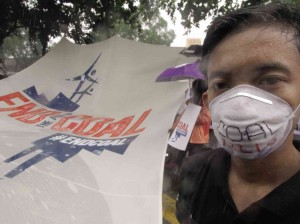Business World Online
Posted on June 30, 2013 09:38:28 PM
THE COMMERCIAL implementation of retail competition and open access (RCOA), which began June 26, is off to a good start, based on feedback as the Energy department received from initial customers.
ELECTRICITY METER -- BW File Photo
Mr. Petilla added that the department cannot disclose the prices of the customers’ electricity, based on contracts with suppliers.
"But I heard, what they got is lower than what they originally pay to their DUs (distribution utilities). Rest assured that customers got better deals and services than the previous, when they don’t get to choose their DUs," Mr. Petilla said.
Contestable customers are electricity end-users whose average monthly peak consumption is at least one megawatt (MW).
Under the RCOA, contestable customers can choose their own suppliers, who in turn can provide tailored supply packages based on each customer’s consumption and preferences.
In a text message on Saturday, Philippine Electricity Market Corp. (PEMC) President Melinda L. Ocampo said: "The launching of RCOA was successful. There were some contestable customers who tried to meet the June 26 effectivity [of their contracts] but we need to strictly follow the rules on the applicants’ compliance to complete the requirements."
"Maybe, on the next billing period, we will be able to approve them. PEMC will continue to monitor the implementation [of RCOA]," she added.
PEMC is the central registration body of RCOA. In a statement last week, PEMC said the 239 registered customers chose these DUs: Aboitiz Energy Solutions, Inc. (45 customers); Adventenergy, Inc. (5); DirectPower Services, Inc. (29); Manila Electric Co. (151); Masinloc Power Partners Co. Ltd. (1); San Miguel Electric Corp. (1); and TeaM (Philippines) Energy Corp. (7).
Even though the 239 are less than a third of the 909 customers accredited by the Energy Regulatory Commission (ERC), PEMC has said that it hopes the rest will be able to secure supply offers that suit their needs by the end of the year.
Mr. Petilla said that the remaining customers should continue toward securing contracts.
"Those who don’t have contracts yet remain with their DUs until such time that they get contracts, but they should continue negotiating with suppliers and secure a contract. If they don’t have contracts by December, then they will source their power through SOLR (supplier of last resort), which will source power requirements from the WESM (Wholesale Electricity Spot Market)," he said.
Mr. Petilla added that the six-month period is ample time for the other contestable customers to see how they might benefit from RCOA.
"So now, they don’t know how to manage their electricity, but we expect them to see the benefits of RCOA and their power to choose as this thing goes along," the Energy secretary said.
"Some of the customers are still learning, and a lot are still adjusting. So, we expect questions from them, and we continue to educate them. In the next few months, we expect to see how the market will behave with the RCOA," he added.
Mr. Petilla also emphasized that since long-term contracts are not allowed under RCOA, the department expects that customers will choose the suppliers that give them the best electricity service.
"They have the benefit of switching to another supplier [on a monthly basis] starting Dec. 26 if they choose to do so. They should maximize that," Mr. Petilla said.
Ms. Ocampo, meanwhile, said that PEMC will be meeting with its technical working group on a weekly basis to assess the implementation of RCOA, so that the group can also immediately address the problems that might arise along the way.
PEMC’s assessment will go hand-in-hand with the Energy department’s, according to another official.
"So far, no big issues yet on the RCOA implementation. We will be continuously assessing the implementation," Mylene C. Capongcol, Electric Power Industry Management Bureau director, said in a separate text message.
"There will be challenges, and ‘birth pains’ will be experienced; that is why the DoE (Department of Energy) and the ERC are closely working together to avert if not minimize the problems that both the contestable and captive market may experience," she added.
"We look forward to having more competition in the generation and supply sectors that will pave the way for adequate and reliable supply of electricity, as well as transparent and competitive electricity rates."
Only contestable customers will benefit from RCOA in the meantime, but the idea is to eventually bring down the cap for all other customers.
Section 31 of the Electric Power Industry Reform Act (EPIRA) of 2001 provides that two years after the implementation of RCOA, "the threshold level for the contestable market shall be reduced to 750 kW (kilowatts)."
"Subsequently and every year thereafter, the ERC shall evaluate the performance of the market. On the basis of such evaluation, it shall gradually reduce threshold level until it reaches the household demand level…" the EPIRA states.
RCOA had been pushed back at least three times since 2010. -- Claire-Ann Marie C. Feliciano source
